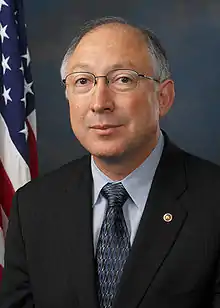Cobell v. Salazar
Cobell v. Salazar auch Cobell v. Babbit, Cobell v. Norton, Cobell v. Kempthorne war eine Sammelklage, die 1996 gegen das Innenministerium und das Finanzministerium der Vereinigten Staaten von der Indianer-Aktivistin Elouise P. Cobell initiiert wurde. Bei der Klage ging es um Missmanagement und Korruption innerhalb des Bureau of Indian Affairs (BIA). Ursprünglich vertrat Cobell unter Anderen den Blackfoot-Indianer James Mad Dog Kennerly aus Montana. Obwohl das BIA sein geerbtes Grundstück an einen Ölkonzern vergeben hatte und sich auf dem Gelände 5 profitable Ölquellen befanden, erhielt dieser lediglich einmal im Monat einen Scheck in Höhe von 30 Dollar vom BIA.[1] Viele weitere Betroffene schlossen sich der Klage an. Die ursprünglich geforderte Summe betrug 176 Milliarden Dollar. Es handelte sich dabei um die größte Sammelklage in der Geschichte der Vereinigten Staaten mit über 500.000 Betroffenen.[2] Der Fall wurde am 8. Dezember 2009 außergerichtlich durch einen Vergleich abgeschlossen. Die Bundesregierung versprach 3,4 Milliarden US-Dollar an die betroffenen Landbesitzer auszuzahlen. Dafür verabschiedete der US – Repräsentantenhaus 2010 den 'Claims Resolution Act of 2010'. Präsident Obama unterzeichnete das Gesetz am 8. Dezember 2010.





Fakten
Am 8. Februar 1887 erließ der US-Kongress den „General Allotment Act“ („Allgemeines Landzuweisungsgesetz“). Später wurde er allgemein als Dawes Act bekannt, nach Senator Henry L. Dawes aus Massachusetts, der ihn ausgearbeitet hatte. Das Reservatsland wurde in 160 Acre große Flächen unterteilt und an jedes Familienoberhaupt der Indianer zur alleinigen Nutzung zugeteilt. Alle unverheirateten Reservatsbewohner über 18 Jahre und minderjährige Waisen wurden mit 80 Acre belehnt, Kinder unter 18 Jahre erhielten 40 Acre und Ehefrauen gar nichts. Die oft ertraglosen Parzellen wurden jedoch erst nach 25 Jahren Eigentum der Indianer. Die Regierung fungierte als Treuhänder. Viele Ureinwohner kannten kein Privateigentum an Grund und Boden und wussten oftmals gar nicht wo ihre Parzellen lagen, bzw. die Parzellen lagen so weit von der Heimat entfernt, dass sie von ihnen nicht bewirtschaftet werden konnten. Da der Dawes Act analog zum Homestead Act aber die Bewohnung und Bewirtschaftung der Parzellen vorschrieb um in das Eigentum an die Besitzer überzugehen, erfolgte der Grundbucheintrag oftmals gar nicht erst. Der formelle Eigentümer war weiterhin das BIA, welches diese Grundstücke an weiße Farmer, Forstunternehmen und andere Interessierte verpachtete, bzw. Schürfrechte an Minenunternehmen, Ölfördergesellschaften und andere Unternehmen vergab und vergibt. Da die Besitzrechte vererbbar waren, sollte das BIA die Einnahmen an die legalen Besitzer aus der Parzellierung von Reservatsland auszahlen. Dies geschah aber oftmals nicht oder in zu geringem Umfang. Auch wurden die Besitzer nicht über die Verpachtungen informiert. Sie erhielten keine Informationen über den Status ihres Besitzes, da das BIA versuchte Klagen zu vermeiden, oder die Gelder innerhalb der BIA veruntreut wurden. Auch wurden die Grundstücke oftmals viel zu billig verpachtet, bzw. Schürfrechte unter Marktpreis vergeben.[3][4][5] Die Parzellierung von Reservats-Land wurde endgültig erst 1934 durch den Indian Reorganization Act gestoppt. Noch heute haben Hunderttausende Besitzansprüche an Grund und Boden aus der Parzellierung von Indianerreservaten, ohne dass es dafür Grundbucheinträge auf ihre Namen gibt. Ohne diesen Eintrag können die Besitzer den Grund und Boden weder selbst bewirtschaften noch in Eigenregie verpachten.
Sonstiges
Während des Prozesses musste das Computer-System und das Computer-Netzwerk des BIA aufgrund von Gerichtsentscheidungen mehrmals abgeschaltet werden. Es bestand der Verdacht, dass Konten und Daten manipuliert worden seien.[6][7][8] Dem zuständigen Richter Royce C. Lamberth des United States District Court for the District of Columbia wurde am 11. Juli 2006 das Verfahren mit der Begründung entzogen er hätte einen Hass gegen das Innenministerium entwickelt und sich auf die Seite der Indianer geschlagen. Er würde einen Krieg gegen das BIA führen[9][10][11] Das Verfahren wurde nach den jeweiligen US-Innenminister benannt der als Beklagter auftrat. Das BIA ist eine Abteilung des Innenministeriums. Da sich das Verfahren über mehrere Regierungen und Legislaturperioden hinzog, erhielt das Verfahren mehrere Namen. Unter Ken Salazar kam es zu der außergerichtlichen Einigung.
Einzelnachweise
- ONE OF COBELL V. NORTON'S unnamed plaintiffs is James Mad Dog Kennerly, a man who should be a prosperous Montanan. One of his hereditary allotments includes as many as five working oil wells. Yet from these he receives a government-issued royalty check for roughly $30 a month, and he lives in a house smaller than a modern walk-in closet.
- Cobell filed her lawsuit in 1996 after years of kinder entreaties failed, demanding payment of all unpaid revenues from Indian leases for the past century, a tally of past revenues, and a new accounting system to deal with future revenues. According to Cobell's forensic accountants, the government owes $176 billion to individual Indian landowners, averaging $352,000 per plaintiff, making this monetarily the largest class-action lawsuit ever launched.
- 1915 Joint Commission of US Congress releases the Report on the Business and Accounting Methods employed in the Administration of the Office of Indian Affairs citing, “…due to the increasing value of his remaining estate, there is left an inducement to fraud, corruption, and institutional incompetence almost beyond the possibility of comprehension”.
- June 5, 2001 The Senate Government Affairs Committee cites Interior’s “abusing the trust of American Indians” as No. 2 in the Government’s Top 10 Worst Examples of Mismanagement. The betrayal of trust includes: 1. Untold billions in income from the use of Indian-owned land, held in trust by the U.S. but “lost” by the Interior and Treasury Departments. 2. $31 million in federal litigation costs.3. $625,000 in fines paid by the US government for contempt-of-court citations in 1999.
- Blackfeet tribe leader Eloise Cobell filed the lawsuit in 1996, several independent investigations found that the Interior Department had never kept complete records, used unknown amounts of the funds to help balance the federal budget, and let the oil and gas industry use Indian lands at bargain rates.
- The court originally imposed the moratorium by stipulation of the government and the plaintiffs in the 1996 Cobell class action litigation. The ban was necessary because the BIA computers were not safe from hackers entering the system and apparently creating their own accounts and moving money between Individual Indian money accounts. U.S. District Court Judge James Robertson turned down the BIA’s request. The new head of the BIA, Asst. Secretary Carl Artman, claims the BIA is severely limited in its operations and communications by this continuing ban on BIA internet useage. Artman also contests the Cobell plaintiffs claim that the case is worth $100 billion.
- DOI's Internet connection shut down for third time TUESDAY, MARCH 16, 2004 The federal judge handling the Indian trust fund lawsuit ordered the Department of Interior to shut down its Internet connection on Monday, a move that plunged many of the agency's computer systems back into the dark ages. For the third time since December 2001, U.S. District Judge Royce Lamberth blasted the department for failing to correct known security vulnerabilities. In a 29-page decision, he called Interior "incapable" of ensuring that billions of dollars of Indian money are safe from computer hackers.
- Because it is indisputable that the 'poor state of network security' creates an imminent risk of irreparable injury... plaintiffs request that this court disconnect from the Internet and shut down each information technology system which houses or access individual Indian trust data to protect plaintiffs against further injury to their interests...
- Washington Post A federal appeals court took the rare step of removing U.S. District Judge Royce C. Lamberth from a long-standing legal battle involving billions in Native American oil and gas royalties, saying the judge appears to be biased against the Interior Department.
- Judge Lamberth bifurcated the case along those lines. After a trial on Phase One - reform of the system - Judge Lamberth ruled on December 21, 1999 that the secretaries of Interior and Treasury had breached their trust obligations to the Indians.
- Judge Lamberth orders Secretary Norton and Assistant Secretary for Indian Affairs McCaleb to stand trial for contempt.
Weblinks
- Elebrates the Life of this Native American woman that has the Courage deep enough to stand up to a Nation, fighting for her rights. This trailblazer of a Woman is working as Lead Plaintiff in case seeking royalties for all her Native Family. (englisch)
- Artikel über Cobell Los Angeles Times (englisch)
- Claims Resolution Act of 2010 (englisch)
- Indian Trust Settlement (englisch)
- Elouise Cobell's Accounting Coup A profile of the late Blackfoot woman who successfully sued the federal government for billions on behalf of ripped-off Native Americans. (englisch)
- The History Behind the Cobell Case (englisch)
- Historical Timeline of Indian Trust Funds Management (englisch)